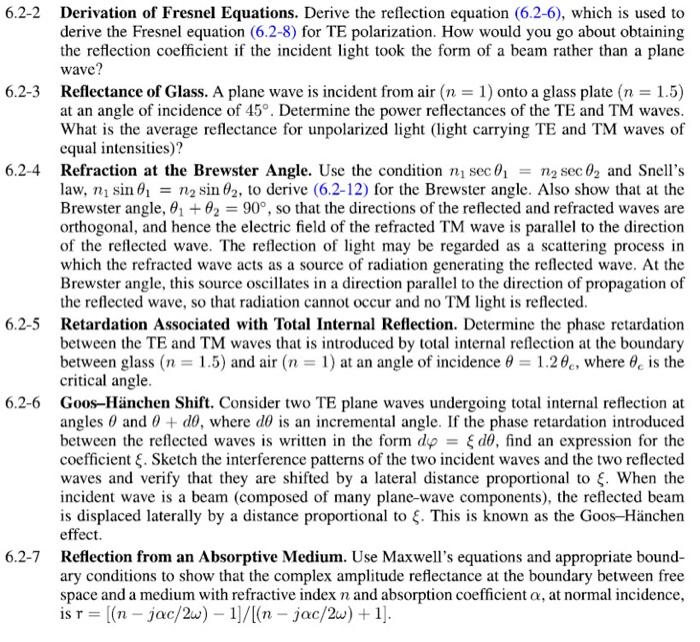Answered step by step
Verified Expert Solution
Question
1 Approved Answer
6.2-2 Derivation of Fresnel Equations. Derive the reflection equation (6.2-6), which is used to derive the Fresnel equation (6.2-8) for TE polarization. How would

6.2-2 Derivation of Fresnel Equations. Derive the reflection equation (6.2-6), which is used to derive the Fresnel equation (6.2-8) for TE polarization. How would you go about obtaining the reflection coefficient if the incident light took the form of a beam rather than a plane wave? 6.2-3 Reflectance of Glass. A plane wave is incident from air (n = 1) onto a glass plate (n = 1.5) at an angle of incidence of 45. Determine the power reflectances of the TE and TM waves. What is the average reflectance for unpolarized light (light carrying TE and TM waves of equal intensities)? 6.2-4 Refraction at the Brewster Angle. Use the condition n sec 0 = n sec 0 and Snell's law, n sin 0 = n sin 02, to derive (6.2-12) for the Brewster angle. Also show that at the Brewster angle, 0 +02= 90, so that the directions of the reflected and refracted waves are orthogonal, and hence the electric field of the refracted TM wave is parallel to the direction of the reflected wave. The reflection of light may be regarded as a scattering process in which the refracted wave acts as a source of radiation generating the reflected wave. At the Brewster angle, this source oscillates in a direction parallel to the direction of propagation of the reflected wave, so that radiation cannot occur and no TM light is reflected. 6.2-5 Retardation Associated with Total Internal Reflection. Determine the phase retardation between the TE and TM waves that is introduced by total internal reflection at the boundary between glass (n = 1.5) and air (n = 1) at an angle of incidence 0 = 1.20, where 8, is the critical angle. 6.2-6 Goos-Hnchen Shift. Consider two TE plane waves undergoing total internal reflection at angles 0 and 0 + do, where do is an incremental angle. If the phase retardation introduced between the reflected waves is written in the form dp = d0, find an expression for the coefficient E. Sketch the interference patterns of the two incident waves and the two reflected waves and verify that they are shifted by a lateral distance proportional to . When the incident wave is a beam (composed of many plane-wave components), the reflected beam is displaced laterally by a distance proportional to . This is known as the Goos-Hnchen effect. 6.2-7 Reflection from an Absorptive Medium. Use Maxwell's equations and appropriate bound- ary conditions to show that the complex amplitude reflectance at the boundary between free space and a medium with refractive index n and absorption coefficient a, at normal incidence, is r = [(n-jac/2w) - 1]/[(n-jac/2w) + 1].
Step by Step Solution
★★★★★
3.63 Rating (160 Votes )
There are 3 Steps involved in it
Step: 1
622 623 624 625 626 627 Absorption coefficient Answer Given that Snells Low and to...
Get Instant Access to Expert-Tailored Solutions
See step-by-step solutions with expert insights and AI powered tools for academic success
Step: 2

Step: 3

Ace Your Homework with AI
Get the answers you need in no time with our AI-driven, step-by-step assistance
Get Started


